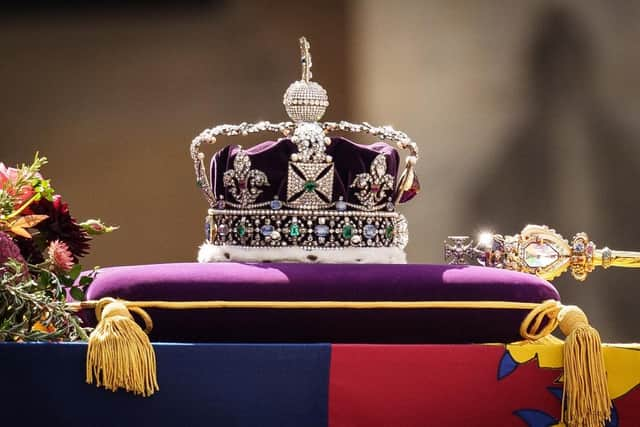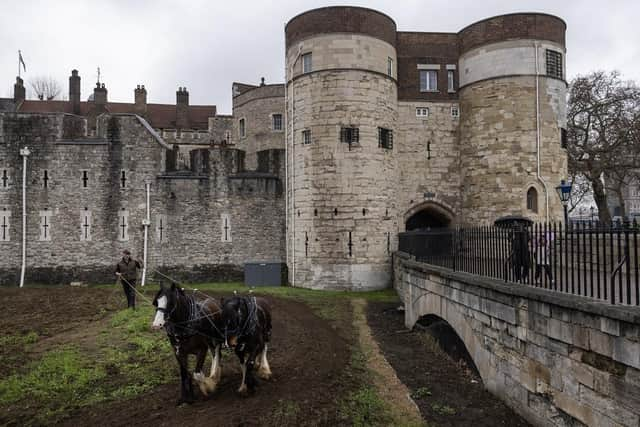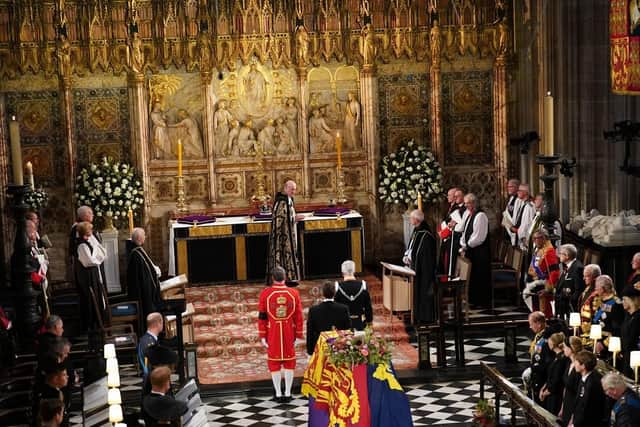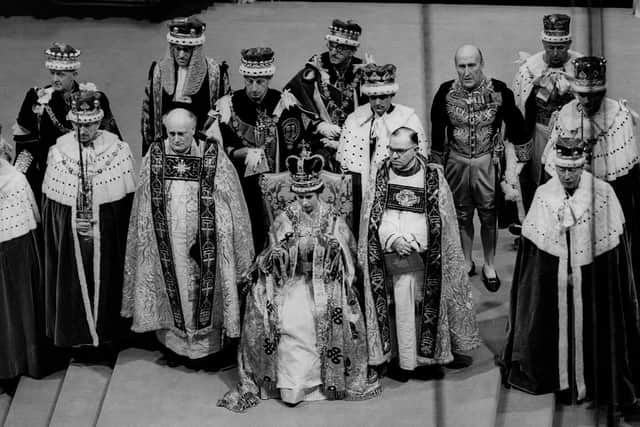King Charles III coronation: What are the Crown Jewels? History of royal treasures, how much they are worth and how to book tickets to see them at Tower of London
The Crown Jewels are the nation’s most valuable and precious treasures, including the Coronation Regalia used at the coronations of new monarchs such as the upcoming coronation of King Charles III in May. The collection consists of more than 100 objects and more than 23,000 gemstones.
They are of incalculable cultural, historical and symbolic value and are part of the Royal Collection held in trust by the monarch for the nation. The collection includes St Edward’s Crown, used only to crown a new king or queen during the coronation ceremony, and the Imperial State Crown, used by the monarch at state occasions such as the State Opening of Parliament.
Advertisement
Hide AdAdvertisement
Hide AdThe Crown Jewels have been protected by the Tower of London and its communities since the 1600s and have attracted visitors from all over the world ever since their creation. Each object is valuable in its own right.


History of the Crown Jewels
Coronation Regalia
The heart of the collection consists of the Coronation Regalia: the sacred objects used during the coronation ceremony. The unique items represent the powers and responsibilities of the monarch.
The Coronation Regalia were most recently used at the coronation of Queen Elizabeth II in 1953 and include the Sovereign’s Sceptre with Cross, the Sovereign’s Orb and the Coronation Spoon.


St Edward’s Crown
This crown is the most important and sacred of all crowns in the collections and is only used at the coronation when the crown is being placed on the head of the new monarch.
Advertisement
Hide AdAdvertisement
Hide AdThe crown is made of solid gold and weighs 2.23kg and is covered in semi-precious stones; it was made for the coronation of Charles II to replace the mediaeval crown melted down by parliamentarians in 1649, following the execution of King Charles I.
This lost mediaeval crown was said to have belonged to the 11th century royal saint, King Edward the Confessor.


Imperial State Crown
This is the crown that the monarch wears as they leave Westminster Abbey after the coronation and it is also used on other State occasions including the yearly State Opening of Parliament.
It is made of gold and set with 2,868 diamonds, 17 sapphires, 11 emeralds, 269 pearls and four rubies. It contains some of the most well known jewels in the collection including the Black Prince’s Ruby, the Stuart Sapphire and the Cullinan II diamond.
Advertisement
Hide AdAdvertisement
Hide AdSt Edward’s Sapphire, set in the centre of the topmost cross, is said to have been worn in a ring by St Edward the Confessor and discovered in his tomb in 1163.


The Imperial State Crown was created for the coronation of King George VI in 1937, replacing Queen Victoria in 1838.
Sovereign’s Sceptre with Cross
This item has been used at every coronation since Charles II’s in 1661; it was transformed in 1910 for George V by the addition of the Cullinan I diamond and it is valued at 530.2 carats; it is the largest colourless cut diamond in the world.
The Cullinan Diamond was unearthed in 1905, in modern-day South Africa. On January 26, 1905, Frederick Wells, the mine’s surface manager, was alerted to a shiny object flashing in the wall of the mine, he prized it our and it was named after the mine’s chairman, Sir Thomas Cullinan.
Advertisement
Hide AdAdvertisement
Hide AdThe 3106 carat diamond was cut to create nine major stones and 96 smaller ones; it took three polishers working 14-hour days and eight months to complete the nine largest stones.
Sovereign’s Orb
This golden globe is one of the objects presented during the coronation representing their powers and responsibilities; this is called the investiture. It is a golden globe surmounted by a cross and reminds the monarch that their power is derived from God.
Queen Mary II was crowned joint sovereign with her husband King William III in 1689 and as joint monarch, Mary II required her own regalia for their coronation, rather than using the traditional consort’s regalia.
Koh-i-Nur
This diamond is one of the most famous diamonds in the world and possibly originated from the Golconda mines in central southern India. It has a turbulent history; a symbol of conquest, the Koh-i-Nur has had many previous owners including Mughai Emperors, Shahs of Iran, Emirs of Afghanistan, and Sikh Maharajas.
Advertisement
Hide AdAdvertisement
Hide AdIn 1849, the East India Company took the jewel from deposed 10-year-old Maharaja Duleep Singh, as an order of the Treaty of Lahore. This symbolised the end of the Anglo-Sikh wars in the Punjab, present day northern India and eastern Pakistan. The Treaty specified that the jewel should be surrendered to Queen Victoria.
The diamond weighs 105.6 carats and was once much larger but was re-cut in 1852 to improve its value and conform to contemporary European standards.
Recent legend states that it would bring misfortune if it is worn by a man and the Koh-i-Nur is now set in the Crown of Queen Elizabeth the Queen Mother in 1937.
Coronation Spoon
This is thought to be the oldest objects in the collection; it was created in the 12th century and is used for anointing the sovereign with holy oil, the most sacred part of the coronation ceremony.
Advertisement
Hide AdAdvertisement
Hide AdThe Spoon survived Parliament’s destruction of the Crown Jewels in 1649 due to the fact that it was bought by a man called Clement Kynnersley, who was an official of the royal wardrobe of Charles I and was one of the commissioners who organised the sale of the late king’s goods.
Once it was restored in 1660, Kynnersley returned the Coronation Spoon to Charles II, possibly as an attempt to win back the royal favour.
How much are the Crown Jewels worth?
Whilst the jewels are said to be priceless, many experts have attempted to value their worth and estimated they would be worth between £1 billion and £5 billion, though they have never been officially appraised.
The Cullinan I diamond is estimated to be worth as much as £40 million alone.
How can I see the Crown Jewels up close?
Advertisement
Hide AdAdvertisement
Hide AdThe Crown Jewels are kept under armed guards in the Jewel House at the Tower of London and every year visitors from far and wide travel to the venue to see them.
You can pre-book your ticket and time slot to visit the Crown Jewels on the Tower of London website before your trip or buy tickets on the day from the ticket office on Tower Hill. Audio guide tours are also available in a choice of languages.
The Tower of London admission ticket includes entry to the Crown Jewels, the White Tower, Chapel of St Peter ad Vincula, Battlements, Mediaeval Palace, Bloody Tower, Torture at the Tower exhibition, Fusiliers Museum and Royal Mint exhibition.
However, the Imperial State Crown and Queen Mary’s Crown are not currently available for public viewing as they are being prepared for the coronation.
These are the ticket prices until Thursday, May 25, 2023.
Members (free)
Adults ages 18 to 64 (£29.90)
Child age five to 15 (£14.90)
Child age 0 to four (free)
Concession (£24)
Advertisement
Hide AdAdvertisement
Hide AdFamily of one adult and up to three children aged five to 15 (£52.20)
Family of two adults and up to three children aged five to 15 (£82.10)
Groups of 15 or more (£27.60)
These are the ticket prices from Friday, May 26, 2023.
Members (free)
Adults ages 18 to 64 (£33.60)
Child age five to 15 (£16.80)
Child age 0 to four (free)
Senior age 65 plus (£26.80)
Full time student, 16-17 years (£26.80)
Disabled Concession (£26.80)
Disabled Carer/Companion (free)
Groups of 15 or more (£27.60)
Comment Guidelines
National World encourages reader discussion on our stories. User feedback, insights and back-and-forth exchanges add a rich layer of context to reporting. Please review our Community Guidelines before commenting.
